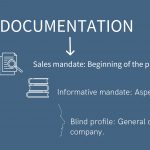If you are a company owner, you may have never considered your company’s sale, but it is a world surrounded by technicalities and processes that you may not understand.
As specialists in companies’ sales, we can help you understand the key documents you need in each phase of a sale
A company sale and purchase operation is undoubtedly a complex process that requires a team of consultants specialized in the company’s activity sector. Below, we detail the main phases of a company’s sale process and the necessary documentation for each of them, giving the key details on each of these stages.
Next, we will analyze the different documents necessary within each stage of the sale of a company:

Strategic analysis of alternatives.
The first step when deciding that a company is going to be sold is to analyze which process we want to carry out and carry out an analysis of it, as well as of the company to be sold.
Once you decide to sell your company and the type of transaction you want to carry out, the next step is to sign a sales mandate.
This document specifies what the costs derived from the sale will be for the sold company. The signing of this signifies the beginning of the sale process of the company.
Once the consultants start working on the mandate, the first thing they will do is request information about the company. All the information required will be essential for preparing the necessary documentation for the execution of the sales process.
The first document produced is usually the so-called blind teaser.
The blind profile (or teaser) is a document that includes the general characteristics of the company being sold but doesn’t contain any information that would make it possible to identify the company. This document is the first document that potential buyers will be shown to help them decide whether or not they are interested in buying your company. They are approximately two pages long, and contain general information regarding the company and its operations.
The blind profile includes a description of the main characteristics of the company, the reason why the owner(s) wants to carry out the sale, key financial figures from recent years in terms of sales, profits and debt, the expected growth projection for the next three years and the advantages that this operation can bring to the investor. In the blind profile, it is not advisable to include a price since you establish a limit before even the first negotiation.

Preparation of a sales notebook or company report.
After the teaser, the next document should provide more information about the company to potential investors (once they sign a confidentiality letter or NDA).This is the Sales Notebook.
This document will consist of six main sections:
- Executive Summary
- Vision of the sector and subsector in which it competes
- Study of the company, from its inception until now, analysis of threats, strengths, weaknesses and existing opportunities
- List of competitors, market share and competitive strategies
- Financial data
- Growth potential
The company’s sales notebook’s objective is to provide potential investors with all the necessary information to know if the investment may be interesting for them or if, on the contrary, they should not continue participating in the process. The notebook should reflect the reality of the company, as well as its most positive aspects.
The key to this phase lies in the professional presentation of the information, establishing transparency and seriousness parameters. Unlike the blind profile, this document gives the necessary data to identify your company and provides potential buyers with more details.
Assessment report and contact with candidates.
Once you have the blind profile and the sales notebook, it is time to know how much your company is worth so that you can start negotiating the sale; this process is called a valuation and will result in the creation of a Valuation Report.
The preparation of a valuation report is an essential job; it can enable a better negotiation with investors and help you to maximize the price of the company by having logical and worked numerical arguments to support your case. Furthermore, evaluating your company will help you know where you are starting from, your company’s position in the market, and its value.
Business valuation is a necessary activity in most corporate operations.
Once you have all these documents, you will have to decide which candidates best suit the proposed operation; for this, a Mapping of potential counterparts is carried out, made up of two lists (a longlist and a shortlist) of investors who potentially fit the purchase of the company.
A mapping of potential counterparts, a list of companies to contact, is the most feasible for this search. You will have to find all the candidates whom may be interested in purchasing your company. This mapping will be our pillar upon which the entire search and negotiation process will be supported.
At this time, it is essential to have good advisors who look for and find the best buyers for your company since it is a crucial moment on which the sale agreement that is made totally depends.
Often, the best buyer is not the most obvious, such as a domestic buyer or a competitor of yours, but a less obvious choice, like a company from a related sector, for example.
After creating the list of potential investors and having contacted them, the next phase is marketing. The first thing is to create a Confidentiality Agreement or NDA, which contains details about what information is confidential, which both parties are subject to. After this, interested buyers can receive the company’s Sales Notebook.
Next, interested investors will have to issue a first Indicative Offer or letter of interest. They will detail, without legal validity, the offer that they propose to the company, including information such as the price they offer, how it would be paid and the purchase deadlines.
An indicative offer can have a significant impact on an entrepreneur who until then had never considered selling his business, as Enrique Quemada, president of ONEtoONE explains;
A businessman once told me that, while he was in a meeting, a messenger arrived at his company and insisted that they had to personally deliver a letter to him. The businessman went out, picked it up, and read the letter. In doing so he came across an indicative offer on his business. He couldn’t believe it. “They want to buy me!” He thought. And he began to imagine what he was going to do next, what he would do with the money and how to tell his family about it.
Negotiation and Due Diligence Process.
Once indicative bids are obtained from the candidates, the agreement of intent – also called the Agreement of Intent or Letter of Intent (LOI) – is signed with the potential buyer with whom there is the best fit. This agreement of intent declares the commitment to begin a negotiation of the pending aspects of the deal that will eventually culminate in a definitive contract of sale. The seller’s strength is much greater before the agreement of intent than after; which is why it is essential to reach this point with the highest level of understanding and trust possible.
The agreement of intent sets the basis for the negotiation and establishes a reference figure on the price to be paid. The points on which an agreement have to be reached are established, and time limits are set to close the negotiations.
Once the buyer feels comfortable with their offer and wants to take it to the next level, the so-called Binding Offer is made, an offer that does have legal value and indicates the conditions of the purchase that the investor offers your company.
After the agreement of intent comes the Due Diligence, the most sensitive part of the process, which consists of checking all the documentation and information previously delivered. It is a very complex process that requires a great deal of preparation on the seller’s part, mainly in correcting possible irregularities in management and ordering all the documentation correctly.
Once the first direct contacts between the parties begin, the negotiation phase begins. Depending on the level of negotiation, the negotiating parties can program a Data Room so that access to information for the different buyers is more easily managed by the seller. Finally a controlled auction process is held with the participation of the shortlisted candidates with serious purchasing intentions.

Closing of the Sale.
Once an agreement has been reached, it is time to close the sale; thus, the so-called Purchase Agreement or SPA will be signed.
This document details all the information about the transaction and is one of the most important documents in the entire process since it includes all the conditions under which the sale will occur. That is why it is essential to have a good team capable of achieving the best agreement for you and your company.
The sales notebook must include these sections:
- Description of the transaction.
- Terms of the agreement.
- Representations and guarantees.
- Limits on liability.
- Conditions.
- Annexes.
The process of selling a company is very complex. That is why it is essential to have the help of a company specialized in mergers and acquisitions, since they will take care of all the steps and advise the selling party on everything they need. Do not hesitate to contact us!
At ONEtoONE, we are characterized by the transparency, confidentiality, and professionalism with which we handle our clients’ operations. One of our best allies is the trust we generate through our work. Therefore, we encourage you to contact us if you seek advice for the sale of your company. And remember, confidentiality is the key to success.





